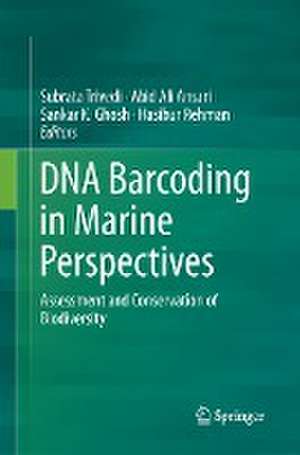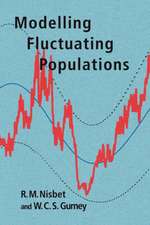DNA Barcoding in Marine Perspectives: Assessment and Conservation of Biodiversity
Editat de Subrata Trivedi, Abid Ali Ansari, Sankar K. Ghosh, Hasibur Rehmanen Limba Engleză Paperback – 15 iun 2018
| Toate formatele și edițiile | Preț | Express |
|---|---|---|
| Paperback (1) | 946.72 lei 6-8 săpt. | |
| Springer International Publishing – 15 iun 2018 | 946.72 lei 6-8 săpt. | |
| Hardback (1) | 952.72 lei 6-8 săpt. | |
| Springer International Publishing – 7 sep 2016 | 952.72 lei 6-8 săpt. |
Preț: 946.72 lei
Preț vechi: 1154.54 lei
-18% Nou
Puncte Express: 1420
Preț estimativ în valută:
181.18€ • 187.17$ • 150.79£
181.18€ • 187.17$ • 150.79£
Carte tipărită la comandă
Livrare economică 25 martie-08 aprilie
Preluare comenzi: 021 569.72.76
Specificații
ISBN-13: 9783319824420
ISBN-10: 3319824422
Ilustrații: X, 330 p. 54 illus., 38 illus. in color.
Dimensiuni: 155 x 235 mm
Greutate: 0.48 kg
Ediția:Softcover reprint of the original 1st ed. 2016
Editura: Springer International Publishing
Colecția Springer
Locul publicării:Cham, Switzerland
ISBN-10: 3319824422
Ilustrații: X, 330 p. 54 illus., 38 illus. in color.
Dimensiuni: 155 x 235 mm
Greutate: 0.48 kg
Ediția:Softcover reprint of the original 1st ed. 2016
Editura: Springer International Publishing
Colecția Springer
Locul publicării:Cham, Switzerland
Cuprins
1. DNA Barcoding in the Marine Habitat: An Overview.- 2. Measurement of a Barcode’s Accuracy in Identifying Species.- 3. DNA barcoding: a tool to assess and conserve marine biodiversity.- 4. Safety Assessment and authentication of seafood through DNA barcoding.- 5. Bioinformatics tools in Marine DNA Barcoding.- 6. Morphological and COI sequence based charactersation of Marine Polychaete Species from Great Nicobar Island, India.- 7. Revised Phylogeny of Extant Xiphosurans (Horseshoe Crabs).- 8. DNA Barcoding in marine nematodes: successes and pitfalls.- 9. DNA barcoding of calanoid copepods from the gulf of california.- 10. DNA Barciding of Primitive Species - Nemertine from Sundarbans Marine Bio-Resourse.- 11. Future Perspectives of DNA Barcoding in Marine Zooplanktons and Invertebrates.- 12. Molecular Positioning of Living Fossils (Horseshoe Crab) Using DNA Barcoding Approach.- 13. Mitochondrial DNA diversity of Wild and Hatchery Reared Strains of Indian Lates calcarifer (Bloch).- 14. Barcoding Antarctic fishes: species discrimination and contribution to elucidate ontogenetic changes in Nototheniidae.- 15. Barcoding of Indian marine fishes: For identification and conservation.- 16. DNA barcoding Identifies Brackish Water fishes from Nallavadu Lagoon, Puducherry, India.- 17. DNA Barcoding of Marine fish: Prospects and Challenges.- 18. DNA Barcoding in Phytoplankton and other algae in Marine Ecosystem: An Effective Tool for Biodiversity Assessment.- 19. A search for a single DNA barcode for seagrasses of the world.
Notă biografică
Dr. Subrata Trivedi, Ph.D
Department of Biology
Faculty of Science
University of Tabuk
Tabuk, Kingdom of Saudi Arabia
striverdi@ut.edu.sa
triverdi.subrata@gmail.com
Abid A Ansari
Department of Biology
Faculty of Science
University of Tabuk
Tabuk-71491, Kingdom of Saudi Arabia
aansari@ut.edu.sa
aaansari40@gmail.com
Dr. Sankar K. Ghosh, Ph.D.
Department of Biotechnology,
Assam University
Silchar-788011
Assam, India
Sankar.kumar.ghosh@aus.ac.in
drsankarghosh@gmail.com
Hasibur Rehman, Ph.D
Department of Biology
Faculty of Sciences
University of Tabuk
Tabuk, Kingdom of Saudi Arabia (KSA)
Department of Biology
Faculty of Sciences
University of Tabuk
Tabuk, Kingdom of Saudi Arabia (KSA)
hrehman@ut.edu.sa
Textul de pe ultima copertă
More than two third area of our planet is covered by oceans and assessment of marine biodiversity is a challenging task. With the increasing global population, there is a tendency to exploit marine recourses for food, energy and other requirements. This puts pressure on the fragile marine environment and necessitates sustainable conservation efforts. Marine species identification using traditional taxonomical methods are often burdened with taxonomic controversies. Here in this book we will discuss the comparatively new concept of DNA barcoding and its significance in marine perspective. This molecular technique can be useful in the assessment of cryptic species which is widespread in marine environment and linking the different life cycle stages to the adult which is difficult to accomplish in the marine ecosystem. Other advantages of DNA barcoding include authentication and safety assessment of seafood, wildlife forensics, conservation genetics and detection of invasive alien species (IAS). Global DNA barcoding efforts in the marine habitat include MarBOL, CeDAMar, CMarZ, SHARK-BOL, etc. DNA barcoding of different marine groups ranging from the microbes to mammals is to be revealed. In conjugation with newer and faster techniques like high throughput sequencing, DNA barcoding is serving as an effective modern tool in marine biodiversity assessment and conservation.
Caracteristici
This is the first published volume on this research topic. It provides an account of selected research projects and case histories from sites and/or laboratories working on marine biodiversity around the globe, and addresses the role of DNA barcoding combined with enhanced sequencing for the assessment and conservation of marine biodiversity. Includes supplementary material: sn.pub/extras
















